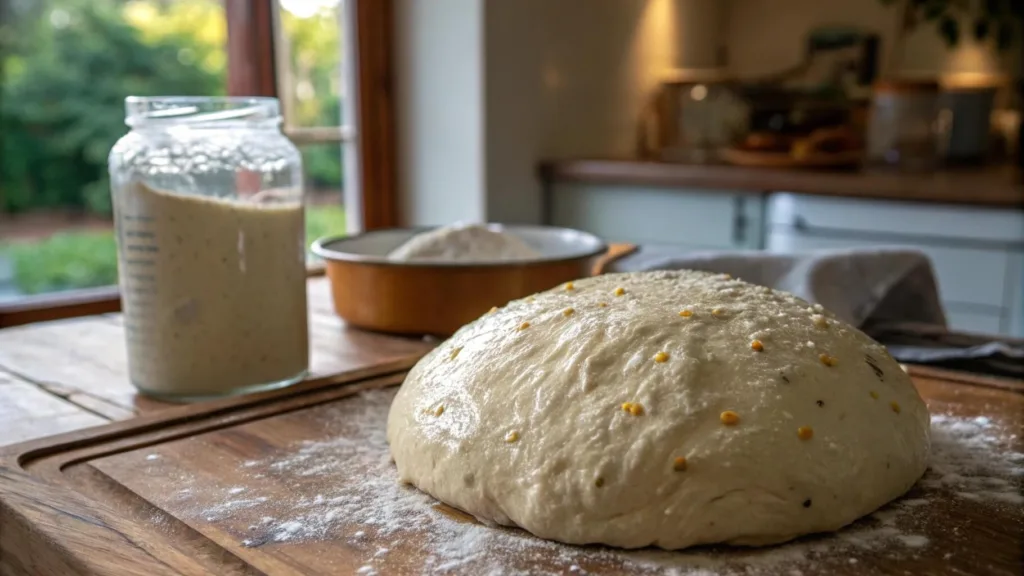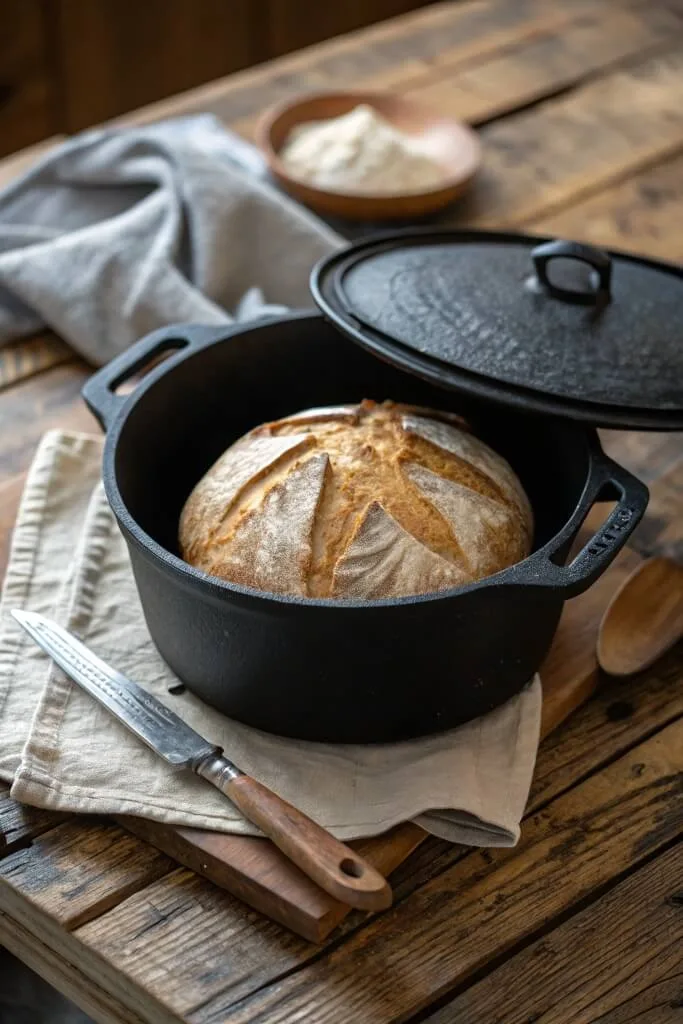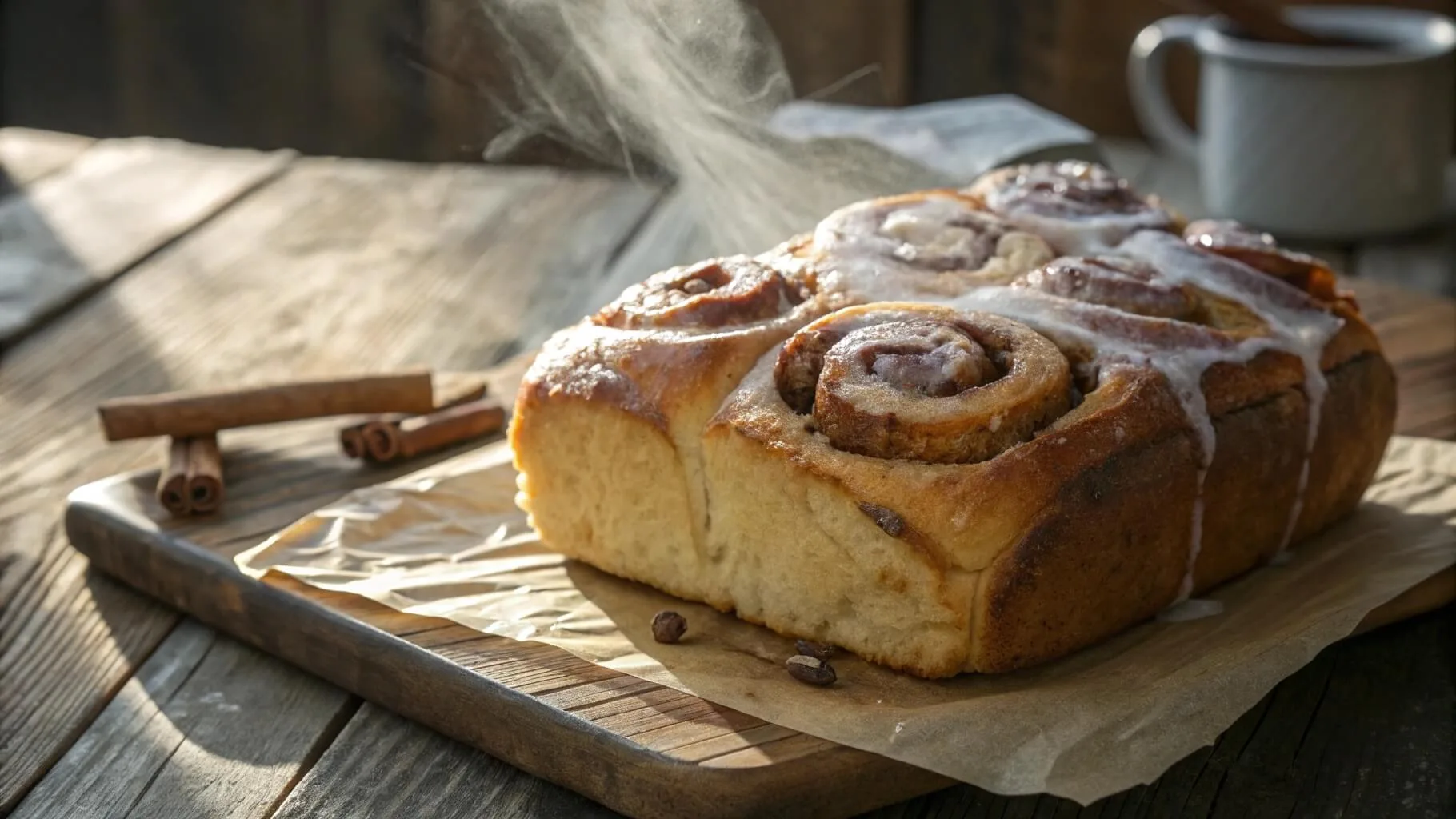There’s something truly magical about the aroma of freshly baked bread wafting through your kitchen. For me, it’s more than just a hobby—it’s a passion that brings warmth and joy to my home. Today, I want to share with you how to create a loaf that’s as delightful as it is satisfying: sourdough cinnamon bread.
Imagine this: the moment you step into your kitchen, the scent of warm cinnamon and tangy sourdough fills the air. That’s the kind of experience we’re aiming for. This isn’t just bread; it’s a celebration of flavors and textures that come together to create something extraordinary.
What makes sourdough cinnamon bread so special? It’s the perfect blend of the earthy tang of sourdough and the cozy warmth of cinnamon. But don’t let its simplicity fool you—mastering the balance can be a bit of a challenge. However, with the right approach, it’s entirely achievable, even for those new to sourdough baking.
Throughout this guide, I’ll walk you through every step, from nurturing your sourdough starter to achieving the perfect bake. Whether you’re a seasoned baker or just starting out, this recipe is for you. By the end, you’ll have the knowledge and confidence to create a loaf that’s as impressive as it is delicious.
So, let’s get started on this delicious journey. With a little patience and a lot of love, you’ll be enjoying the fruits of your labor in no time. Happy baking!
Gathering Your Ingredients and Equipment
Before diving into the delicious world of sourdough baking, it’s essential to have everything you need on hand. A well-prepared workspace and quality ingredients will set you up for success. Let’s break down what you’ll need to craft that perfect loaf.
Essential Ingredients Overview For sourdough cinnamon bread
Your recipe will thrive with high-quality flour, active sourdough starter, and a generous pinch of sugar. Brown sugar adds depth, while fresh cinnamon brings warmth. Don’t forget the raisins—they’re a delightful addition that enhances the loaf’s texture and flavor.
Each ingredient plays a crucial role. Flour provides structure, the sourdough starter adds tang, and sugar balances the flavors. Even a small variation in measurements can affect the outcome, so precision is key. I recommend using a digital scale for accuracy.
Must-Have Baking Tools
Having the right tools makes all the difference. A Dutch oven is a baker’s best friend for creating a crispy crust. A banneton helps shape the dough, while a dough scraper ensures clean cuts. I personally love using the OXO Good Grips Dough Scraper—it’s durable and easy to handle.
A clean, organized workspace is just as important as the tools themselves. Take a few minutes to gather everything before you start. This way, you can focus on the process without distractions. Remember, a little preparation goes a long way!
With these ingredients and tools, you’re ready to take the next step in your baking journey. Let’s get started on activating your sourdough starter and bringing this recipe to life!
Preparing Your Sourdough Starter and Dough
Before you can create that perfect loaf, you need a strong and active sourdough starter. I’ll walk you through my personal routine for activating and feeding my starter, sharing tips I’ve learned along the way.
First, ensure your sourdough starter is active. I feed mine daily with a mix of 50g of flour and 50g of water. This ratio keeps it healthy and ready for baking. Consistency is key, so I recommend setting a routine that works for you.
When it’s time to prepare the dough, I use a mix of all-purpose and bread flour for the perfect balance. Measure carefully—accuracy is crucial for consistent results. I’ve learned that even a small variation in temperature or timing can affect fermentation, so I keep my kitchen at a steady 75°F.
Here are a few tips I’ve picked up: Use a digital scale for precise measurements Keep your starter in a warm, draft-free spot Feed your starter at the same time each day
Remember, a healthy starter is the foundation of great bread. By paying attention to temperature and feeding schedules, you’ll be on your way to creating a delicious loaf in no time.
The Autolyse and Bulk Fermentation Process
Mastering the autolyse and bulk fermentation process is key to achieving a delicious loaf. This step is where the magic happens, transforming your dough into a flavorful and elastic mixture. Let’s dive into how to make the most of this stage.

Understanding the Autolyse Step
The autolyse step is all about letting the dough rest. After mixing your starter, water, and flour into a shaggy mixture, cover it and let it rest for about 30 minutes. This resting period allows the dough to hydrate evenly, which is crucial for developing the perfect texture. By giving the dough time, you’re setting the stage for a light and airy crumb.
Achieving the Perfect Bulk Ferment
Once the autolyse is complete, it’s time to develop the dough’s structure. Gently fold the dough with your hand every 30 minutes for the first 2-3 hours. This process, known as bulk fermentation, is where the dough develops its strength and flavor. Cover the dough loosely to maintain moisture but allow gases to escape. After 4-6 hours, you’ll notice the dough has doubled in size and has a bubbly texture—this means it’s ready for the next step.
Remember, patience is key. A well-rested dough makes all the difference in the final product. By following these steps, you’re ensuring a loaf that’s both flavorful and full of character.
Mastering Sourdough Cinnamon Bread Flavor
Crafting the perfect flavor profile for sourdough cinnamon bread is both an art and a science. The key to unlocking its irresistible taste lies in how you incorporate the cinnamon sugar and, optionally, raisins. Let’s explore how to achieve that balance.
Incorporating Cinnamon Sugar Effectively
Timing is everything when it comes to adding cinnamon sugar. I’ve found that introducing it during the shaping stage yields the best results. This ensures the yeast remains active and the dough ferments properly. To create that perfect blend, mix the cinnamon and sugar in a small bowl before gently folding it into the dough. A light hand here is essential—just a few gentle folds will do the trick. This method not only enhances the flavor but also keeps the dough’s structure intact, resulting in a beautifully textured loaf.
Enhancing the Dough with Optional Raisins
For those who love a touch of sweetness, adding raisins is a delightful option. I recommend incorporating them during the shaping stage, just like the cinnamon sugar. This ensures they’re evenly distributed, giving every bite a pleasant surprise. To add them, gently mix the raisins into the dough after it’s been lightly oiled. A little goes a long way, so start with a small amount and adjust to your taste. This step transforms your bread into a cinnamon raisin or sourdough cinnamon raisin treat, perfect for breakfast or dessert.
Remember, the goal is to enhance the flavor without overwhelming the dough. By following these steps, you’ll create a loaf that’s as flavorful as it is satisfying. Enjoy experimenting with these techniques and discovering the perfect balance for your taste buds!
Perfecting the Stretch, Fold, and Shaping Technique
Perfecting the stretch and fold technique is essential for creating a light and airy loaf. This method not only builds dough strength but also ensures a delicious crumb structure. Let me walk you through my tried-and-true process.
First, I recommend performing 3-4 sets of stretch and folds, resting the dough for 30 minutes between each set. This allows the dough to relax and develop properly. Be gentle with the dough to preserve those crucial air bubbles that contribute to its rise.
When it comes to shaping, I like to use a combination of water and flour to keep things smooth. Gently shape the dough into a round or bâtard, depending on your preference. This is also the perfect time to incorporate the cinnamon sugar mixture, creating that signature swirl pattern.
Timing is everything in this process. I’ve found that giving the dough enough time to rest between folds is key to achieving the perfect texture. Avoid overworking the dough, as this can lead to a dense crumb. Instead, trust the process and let the dough do its thing.
With a little practice, you’ll master this technique and be rewarded with a beautifully shaped loaf, ready for the next steps in the baking process.
Prepping for the Bake: Oven Setup & Scoring
Creating the perfect bake starts with proper preparation. Today, I’ll walk you through how to set up your oven and prepare your dough for a beautiful finish. Whether you’re using a Dutch oven or a loaf pan, these tips will help you achieve a crispy crust and a perfectly scored top.
Preheating Strategies and Dutch Oven Tips
Preheating your Dutch oven is crucial. I recommend placing it in the oven for at least an hour before baking. This ensures even heat distribution and a crispy crust. If you’re using a loaf pan, make sure it’s well-floured to prevent sticking.
Gently handling the dough is key. Transfer it from the banneton to the preheated Dutch oven or loaf pan with care. Avoid jostling it too much, as this can deflate the dough.
Scoring the top of the dough is both practical and decorative. Use a sharp knife or a bread scoring tool to create a few slashes, helping to control expansion while adding a visually appealing design. I often choose a simple cross shape for a classic look.
To enhance the flavor and appearance, brush the top with butter and sprinkle with your sugar mixture. This adds a sweet crunch and enhances the overall flavor profile. It’s a small step that makes a big difference!
Remember, patience and attention to detail are your allies here. By preheating properly and scoring thoughtfully, you’ll end up with a loaf that’s as beautiful as it is delicious. Happy baking!

Baking, Finishing Touches, and Serving Suggestions
Baking the perfect loaf involves a few key steps that make all the difference. Once your dough is ready, preheat your oven to 450°F and place a Dutch oven inside to heat. Bake for 30-35 minutes, then remove the lid and bake for another 10-15 minutes to achieve a golden crust. I’ve found that this method ensures a perfectly crispy exterior while keeping the inside soft and fluffy.
When it’s time to finish, brushing the bread with butter while it’s still warm adds a delicious sheen and enhances the flavor. I also like to cover it with a clean towel to keep it soft and protect it from drying out. These small touches make a big difference in the final result.
When it comes to serving, the possibilities are endless. Slice it thick and serve with a pat of butter, or transform it into French toast for a weekend breakfast treat. It’s also a hit at brunch—simply slice it, drizzle with honey, and serve with a cup of coffee. Don’t forget to share it with friends or family—it’s always better enjoyed together!
If you’re looking to mix things up, you can even use a stand mixer earlier in the process to mix ingredients like your favorite ingredient or add-ins. This small shortcut can save time while still maintaining that homemade touch. Whether you’re serving it as part of a breakfast casserole or simply on its own, this bread is a crowd-pleaser every time.
FAQs About Sourdough Cinnamon Bread
What does cinnamon do to sourdough?
Cinnamon adds warmth, depth, and a hint of sweetness to sourdough bread. It enhances the overall flavor by balancing the tangy notes of fermented dough with its natural spice. Additionally, cinnamon has antimicrobial properties, which can slightly slow down yeast activity if used in high amounts. This is why some bakers mix cinnamon into the filling rather than directly into the dough to prevent it from interfering with fermentation.
Why is sourdough bread not fattening?
Sourdough bread is considered less fattening than regular white bread because of its lower glycemic index (GI) and higher fiber content. The slow fermentation process helps break down gluten and phytic acid, making nutrients more bioavailable and easier to digest. Additionally, sourdough bread leads to slower carbohydrate absorption, which helps maintain steady blood sugar levels and reduces cravings that lead to overeating.
What is the biggest mistake you can make with your sourdough starter?
The most common and biggest mistake is neglecting your starter—either by not feeding it regularly or by storing it improperly. Other major mistakes include:
- Using chlorinated water, which can kill beneficial bacteria.
- Overfeeding or underfeeding, leading to an unbalanced starter.
- Not maintaining the right temperature, causing slow fermentation or mold growth.
- Discarding too much or too little starter during feedings, which affects strength and consistency.
To keep your starter healthy, feed it consistently, use filtered water, and store it properly based on your baking schedule.
Is sourdough healthier for you than regular bread?
Yes, sourdough is healthier than regular bread due to its natural fermentation process. It offers several benefits, including:
- Better digestion – The fermentation process pre-digests gluten, making it easier on the gut.
- Lower glycemic impact – Sourdough releases sugar into the bloodstream more slowly, preventing blood sugar spikes.
- Rich in probiotics – While baking kills live cultures, the fermentation process creates prebiotics that support gut health.
- More nutrient absorption – Sourdough reduces phytic acid, allowing the body to absorb more essential minerals like iron, magnesium, and zinc.
Why Sourdough Cinnamon Bread is a Must-Try
Sourdough cinnamon bread offers the perfect balance of sweet, spicy, and tangy flavors while delivering numerous health benefits. With its slow fermentation process, it is easier to digest and more nutritious than regular bread. Cinnamon adds not only flavor but also blood sugar-regulating and anti-inflammatory properties. Whether you bake it as a traditional loaf, turn it into cinnamon rolls, or use it for French toast, this bread is a delicious way to enjoy sourdough.
By following the step-by-step guide, avoiding common mistakes, and experimenting with variations, you can master the art of baking sourdough cinnamon bread at home. Give it a try and experience the warmth of homemade bread with the rich complexity of sourdough fermentation and the comforting sweetness of cinnamon.

